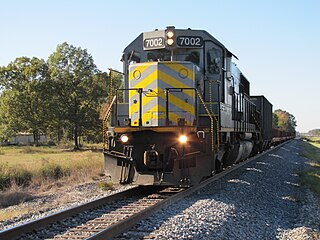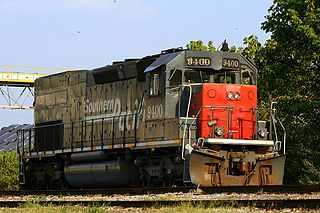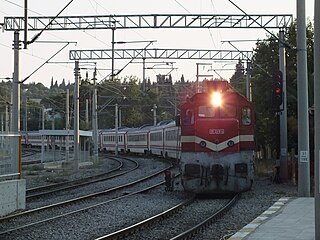
A hood unit, in North American railroad terminology, is a body style for diesel and electric locomotives where the body is less than full-width for most of its length and walkways are on the outside. In contrast, a cab unit has a full-width carbody for the length of the locomotive and walkways inside. A hood unit has sufficient visibility to be operated in both directions from a single cab. Also, the locomotive frame is the main load-bearing member, allowing the hood to be non-structural and easily opened or even removed for maintenance.

The EMD SD40-2 is a 3,000-horsepower (2,200 kW) C-C diesel-electric locomotive built by EMD from 1972 to 1989.

The EMD Dash 2 is a line of diesel-electric locomotives introduced by General Motors' Electro-Motive Division (EMD) on January 1, 1972. Designations of these models were those of the former models with "-2" added. They retained the basic specifications of the earlier models in terms of power output and most other features, but introduced a number of improvements to the locomotives' internal systems, specifically the electrical systems and the trucks of the locomotives. These were intended to improve availability, efficiency, and ease of maintenance.

The EMD SD50 is a 3,500-horsepower (2,610 kW) diesel-electric locomotive built by General Motors Electro-Motive Division. It was introduced in May 1981 as part of EMD's "50 Series"; production ceased in January 1986. The SD50 was a transitional model between EMD's Dash 2 series which was produced throughout the 1970s and the microprocessor-equipped SD60 and SD70 locomotives. A total of 431 were built.

The EMD SD40 is an American 6-axle diesel-electric locomotive built by General Motors Electro-Motive Division between January 1966 and August 1972. 1,268 locomotives were built between 1966 and 1972. In 1972, an improved version with new electronics was developed and marketed as a new locomotive, the SD40-2.

An SDP40 is a 6-axle passenger diesel-electric locomotive built by General Motors Electro-Motive Division (EMD) between June 1966 and May 1970.

The SD45 is a six-axle diesel-electric locomotive class built by General Motors Electro-Motive Division between 1965 and 1971. It has an EMD 645E3 twenty-cylinder engine generating 3,600 hp (2,680 kW) on the same frame as the SD38, SD39, SD40, and SDP40. As of 2023, most SD45s have been retired, scrapped or rebuilt to SD40-2 standards.

The SD39 is a model of 6-axle diesel-electric locomotive built by General Motors Electro-Motive Division between August 1968 and May 1970. 54 were built for American railroads.

The SD45T-2 is a model of diesel-electric locomotive built by EMD for the Southern Pacific Railroad. Like the later SD40T-2 it is colloquially nicknamed a tunnel motor. 247 total units were produced from February 1972 to June 1975, including 84 for SP's subsidiary Cotton Belt. From April 1986 to December 1989, 126 were rebuilt and re-designated as SD45T-2R, including 24 for Cotton Belt.

The passenger locomotives derivatives of the General Motors EMD GP40 diesel-electric locomotive have been, and continue to be, used by multiple passenger railroads in North America. For passenger service, the locomotives required extra components for providing steam or head-end power (HEP) for heating, lighting and electricity in passenger cars. Most of these passenger locomotives were rebuilt from older freight locomotives, while some were built as brand new models.

A comfort cab is a design found on most modern North American diesel locomotives, and some export models. The broad nose occupies the entire width of the locomotive, and typically has an access door on the front of the nose.

The EMD G12 is a class of export locomotive built by GM-EMD, and its Canadian affiliate General Motors Diesel. In addition, Australian licensee Clyde Engineering built ten locomotives for New Zealand in 1957, five for Hong Kong, 23 for Queensland, fourteen for Western Australia and seven for BHP. Australian licensee Commonwealth Engineering also built 42 for Queensland Rail in 1964–66. Many examples were built in the 1950-1960s for railroads around the world.

The G26 is a diesel-electric locomotive built in the US by General Motors Electro-Motive Diesel for export and in Australia by Clyde Engineering under licence. The G26 was developed to increase traction capacities on the tracks which supported lesser axle loadings. They were intended for main line freight and passenger traffic.

TCDD DE 33000 is a type of diesel-electric locomotive built for operations on Turkish State Railways by Tülomsaş. It is model GT26CW-2 designed by General Motors Electro-Motive Diesel and using the famous EMD 645 two stroke diesel engine and using the EMD Dash 2 electronic module. It has been revised to have EMD Dash 3 like microprocessor control in 2017. This batch has air starter.

TCDD DE 24000 is a type of diesel locomotive built for operations on Turkish State Railways (TCDD) by Tülomsaş. 218 units were built between 1970 and 1984 under license from Matériel de Traction Electrique (MTE) of France. The DE 24000 formed the backbone of the dieselisation of the Turkish railways during the 1970s. It follows the hood unit road switcher design, like most Turkish mainline locomotives. DE 24 000 is the most commonly found locomotive class in Turkey.

TCDD DE22000 are 86 mainline locomotives built for the Turkish State Railways by TÜLOMSAŞ under license by General Motors Electro-Motive Diesel, based on the EMD G26CW-2. The locomotives use GM's 16 cylinder, direct injection 16 645E engine, AR10/D18 AC alternator and a D77-DC traction motor.

The EMD G16 is a diesel locomotive built by General Motors in the US and under licence by Clyde Engineering in Australia and MACOSA in Spain. It has been used in Australia, Brazil, Egyptian Railways, Hong Kong, Israel Railways, Mexico, Spain, Yugoslav Railways and on the successor Croatian Railways, Slovenian Railways, Serbian Railways, Macedonian Railways, Republika Srpska Railways, Kosovo Railways and Railways of the Federation of Bosnia and Herzegovina.
The NRE 2GS36C-DE is a low-emissions six-axle diesel-electric road switcher locomotive built by National Railway Equipment Company. It is part of NRE's N-ViroMotive line. It is powered by two Cummins QSK50L V16 engines rated at 1,800 horsepower (1,340 kW) each, for a total power output of 3,600 horsepower (2,680 kW). It has a starting tractive force of 126,000 pounds-force (560,000 N), an adhesion rate of 30%, and a minimum continuous speed of 13.9 miles per hour (22.4 km/h). It offers Tier III emissions compliance.

The GE PowerHaul is a class of mainline diesel-electric locomotives designed by General Electric. Thirty locomotives were ordered by Freightliner in 2007; the first locomotive was completed in July 2009 at GE's Erie, Pennsylvania, plant.

The EMD FT36CW-2, classified as the Class 7000 locomotive under Korail, was a Korean semi-high-speed diesel locomotive. It was built to make the Saemaul Class trains more streamlined before the 1988 Olympics. The locomotives were built between 1986 and 1987 and were all retired between 2011 and 2012 when they reached the end of their 25-year lifespans.
























